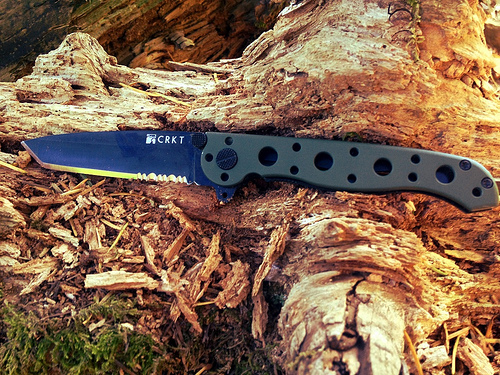Survival Knife
Having a good survival knife is essential in any type of survival scenario. There are many practical uses of a survival knife, including:
- Hunting, skinning, and preparing food.
- Self defense against wild animals (or other people in which case your survival knife doubles as a combat knife).
- Wood cutting for constructing shelter or slicing kindling for starting a fire.
- Slicing rope or cords for storage or shelter construction.
- Making tools such as a spear or stakes to peg stuff to the ground.
- Cutting a path (bush-wacking).
- Digging.
- Opening cans and other containers.
- Hammering (with the handle).
- Surgery and other types of first aid.
- Signaling using the reflective properties of the blade metal.
- Trimming clothing or other loose material.

“ CRKT M-16,” © 2013 by flickr user: Adventure Strong, Username: “Adventure Strong″, used under a Creative Commons Attribution license: http://creativecommons.org/licenses/by/2.0/deed.en
What Is The Best Survival Knife?
There is no “best survival knife.” A lot of it is personal preference. However, there are many things to take into consideration when purchasing a survival knife. As with most things in life, you get what you pay for. Usually, the more expensive the knife, the better quality and durability. Here are some things to consider when looking at the features of different knives:
The Metal
Stainless steel is great because it is virtually indestructible and will not rust. Carbon blades are also good. Some people tend to think that carbon blades will hold an edge longer, but they are not as durable as stainless steel.
Tang
Tang refers to how far down inside the handle the metal of the blade extends. Obviously, the further into the handle the blade goes, the more stable and strong the knife will be. Avoid knives with little to no tang where the blade is just attached to the handle. You want one solid piece of metal that extends more than half-way down into the handle.
Handle
This is really just a matter of personal preference. You want a handle that is comfortable with a nice grip. Avoid hollow handles for storing things because that is an obvious sign that there is little to no tang.
Blade Type
Blade type refers to straight vs. serrated. Serrated blades don’t hold an edge as long as straight blades and they are also harder to sharpen. Serrated blades are better for cutting through rope or other materials that need more of a saw-type action to cut through. If you are choosing between one or the other, I would pick a straight edge for all around versatility and durability. However, there are some good knives with both a straight and a serrated edge that you can use as a dual survival knife.
Length
For a survival knife, you want something with a blade anywhere from 5 to 8 inches. Anything longer than that and its extra unnecessary weight and bulkiness.
Blade Thickness
The thicker the blade the more durable and stable. Look for something around 3/16 to 4/16 of an inch thick. You don’t want a blade that is much skinnier than that because it will be too brittle for the abuse you are going to be putting it through.
In conclusion, finding the best survival knife is a matter of understanding the important features of survival knives and then taking into account your personal preference. I suggest you have a look at Budk Survival Knives. They have a great selection of survival knives and offer a low price guarantee.
Click here for a good guide on different types of knives




[…] The things you should consider when looking for a good survival knife.www.howtosurvivestuff.com/…/a-good-survival-knife-top-thi… […]